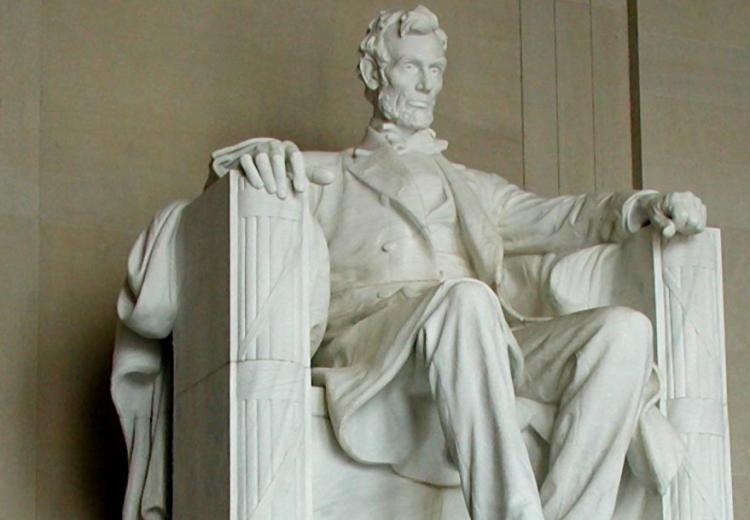Lincoln’s Enduring Legacy

Photograph of the Abraham Lincoln statue in the Lincoln Memorial
Abraham Lincoln’s assassination
On April 14 we commemorate the death of Abraham Lincoln (1809–1865). The years in which Lincoln served as president, 1861–1865, were among the most momentous in America’s history. A month after his election, South Carolina seceded from the Union, triggering a four-year conflict that would leave nearly a million Americans dead or wounded, four million slaves free, and a nation changed forever.
On Good Friday, just a month after the Second Inaugural, and a few days after General Robert E. Lee surrendered his troops to General Ulysses S. Grant, Lincoln was assassinated. As Lincoln took his last breath, Secretary Edwin Stanton was reported to have said, “Now he belongs to the ages.”
Did the assassination transform Lincoln’s reputation?
Lincoln’s tragic death, it is sometimes asserted, transformed a much criticized and controversial president into democracy’s martyr-saint. With this in mind, we culled some of the best NEH-funded resources to guide research into, and study of, the assassination and the way its impact may have changed minds and hearts about Lincoln.
From a virtual tour of Ford’s Theatre and digital newspaper articles to an archive of the inimitable prose and poetry of Walt Whitman, these resources give students a front-row seat as the Lincoln “myth” is created.
But legends and myths are not history. A reading of Frederick Douglass's oration on Lincoln delivered in 1876 on the unveiling of the Freedman's Monument in Washington, D.C., offers an eye-opening account of how the self-taught and erudite former slave viewed Lincoln. While recounting Lincoln’s shortcomings as President, Douglass also notes his accomplishments in the face of nearly insurmountable difficulties. Though constrained by the prejudices and qualms of many whites, Lincoln had successfully preserved the Union and brought about the end of slavery
Douglass reminds us that in order to judge Lincoln fairly, students need to dig into the written records and investigate the historical context of Lincoln’s career, the moral and political standards of his times, and the limitations of the constitutional system for dealing with a problem like slavery.
Over the years, EDSITEment has produced a series of lessons that offer the historical context and ask students to think deeply about important primary and secondary sources. Lucas Morel, the author of Lincoln’s Sacred Effort: Defining Religion’s Role in American Self-Government (2000), co-authored many of these lessons.
The house dividing: historical context
What was America like in the 1830s when Lincoln was coming of age politically? During these years, political events and regional economics produced an alarming split between free and slaveholding states. Heated debates over the abolition of slavery and the powers of the federal government to deal with it characterized American politics. The Growing Crisis of Sectionalism in Antebellum America: A House Dividing introduces students to these developments, which arose from the growing dependence on—and defense of—black slavery in the southern states.
In The Kansas-Nebraska Act of 1854: Popular Sovereignty and the Political Polarization over Slavery, students examine the act that repealed the Missouri Compromise and opened the heartland west of the Mississippi to the expansion of slavery. The lesson contrasts Stephen Douglas’s policy of “popular sovereignty” as an effort to avoid a national crisis over slavery in the territories with Lincoln's counter-argument that both the Declaration of Independence and Constitution committed the national government to extending freedom only, not slavery.
The Kansas-Nebraska Act altered the political balance between free and slave states. In Abraham Lincoln, the 1860 Election, and the Future of American Slavery, students examine the alternatives available to politicians regarding the spread of slavery and the preservation of the American union in the decade leading up to the presidential election of 1860. (For a full online biography of Lincoln up through this period, consult Lincoln/Net, an NEH-funded project.)
The presidency
The decision-making process that precipitated the Civil War is a fascinating subject and the focus of Lincoln Goes to War. In this lesson, students examine the deliberations within the Lincoln administration that led to the defense of Fort Sumter from Confederate attack in April 1861.
While armies clashed on battlefields from Pennsylvania to Louisiana, partisan politics continued in Washington. Congress—as well as in the nation at large—hotly debated issues related to the president's handling of the war. Abraham Lincoln and Wartime Politics examines the controversies arising from Lincoln’s role as a wartime president.
The Union and freedom for all
As commander-in-chief, Lincoln rallied Northern armies to victory over the South. He rarely made public addresses as wartime leader, but when he did they were notable commentaries on the meaning of the war. In them he sought to transform the public perception of the Union from a mere structure of government to a consensus about the future of freedom in America—a future where slavery would eventually be eliminated and liberty protected as the birthright of every human being
The EDSITEment unit A Word Fitly Spoken: Abraham Lincoln on Union explores this rich vein of political reflections on the subject of American national union. By examining Lincoln's three most famous speeches—the Gettysburg Address, the First and Second Inaugural Addresses, as well as a little-known fragment on the Constitution, union, and liberty—students trace what these documents say regarding the importance of the Union for the future of republican government.
Finally, students can see how the stresses and strains of the leadership of the Union in the Civil War transformed Lincoln by examining Alexander Gardner’s photograph of the president taken a few months before his assassination. Gardner’s famous photograph is part of Picture Lincoln, which is built around the rich significance of this image.
